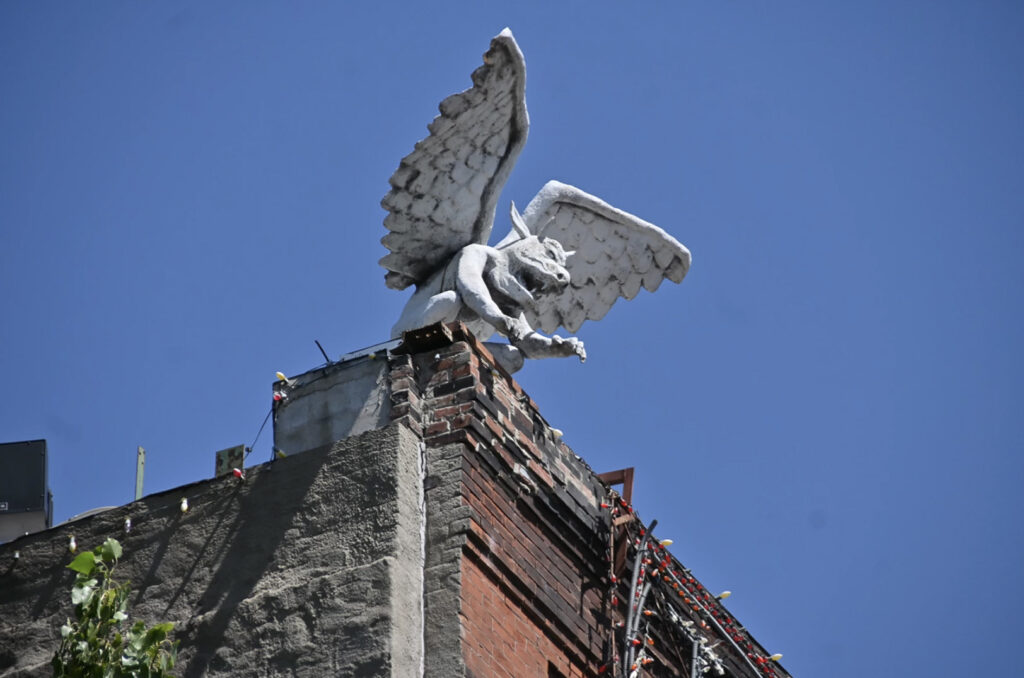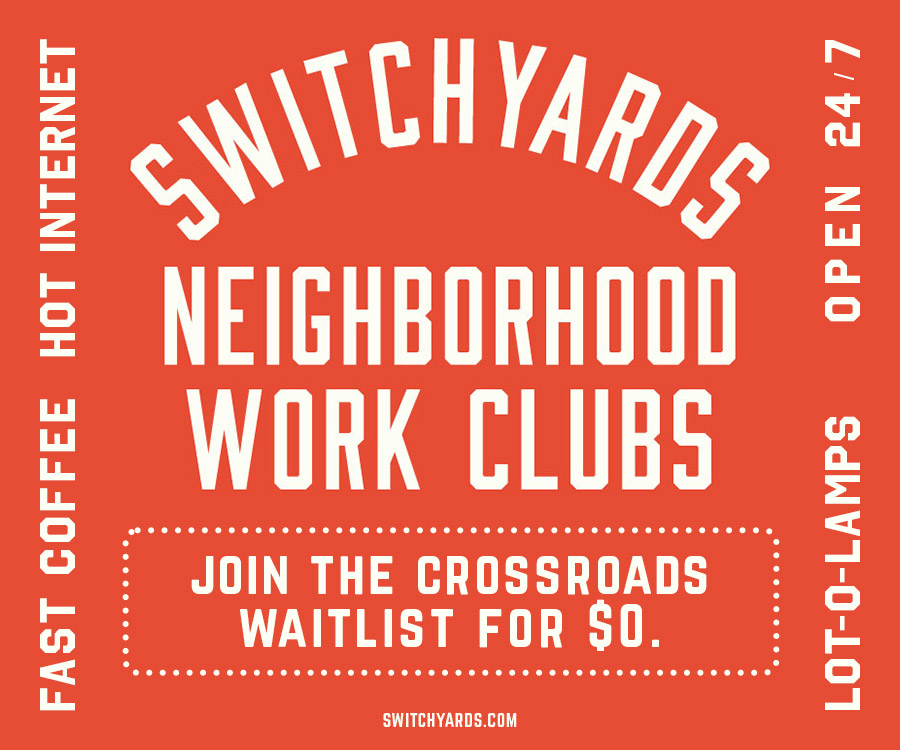Editor’s note: The following story was published by KCUR, Kansas City’s NPR member station, and a fellow member of the KC Media Collective. Click here to read the original story or here to sign up for KCUR’s email newsletter.
A New York developer plans to renovate several historic West Bottoms buildings into apartments and office space, in addition to new construction; The city has provided millions in tax breaks and financing to make the project possible
The first weekend of every month has become a time-honored tradition in the West Bottoms, when crowds of people comb through vintage clothes and antique furniture at shops housed inside the neighborhood’s oldest buildings.
Kansas City resident Holly Robbins went to her first such event on the first Friday in August.
“There’s way more than I imagined,” Robbins said after exploring the antique stores. “I think this is really cool. I’m impressed with my own city after today.”
The West Bottoms has avoided the massive neighborhood transformations that swept Kansas City over the past two decades. The area has remained rooted in its storied past. Historic buildings like the Stockyard Exchange remain standing.
Most roads are unpaved and unmarked. Drivers in the area are met with stop signs, not streetlights, earning the area the nickname “the Wild West.”
Change has come slowly to the West Bottoms, mainly by way of local business owners and developers.
The former economic heart of the meatpacking industry in the Midwest is now slated for a major facelift, as a developer based in New York plans to transform the West Bottoms over the next few years.
SomeraRoad’s plan for the West Bottoms spans 21 acres and costs an estimated $526.7 million. The New York-based developer will construct storefronts, office space, more than 1,200 apartment units and a hotel across 13 developments — some new construction and others renovations of existing historic buildings. The development also includes a public green space and a town square.
Ian Ross, founder and managing partner at SomeraRoad, said the company found the West Bottoms and then decided to develop it.
“We were blown away by the authenticity, the history, the architecture,” Ross said. “It’s really where Kansas City was born. It’s this incredible neighborhood full of these rich, historically significant, historic and architecturally interesting buildings that have such an amazing story to tell and were so under-purposed.”
The plan has received widespread support from Kansas City officials. City Manager Brian Platt said SomeraRoad’s plans will reflect the culture and history of the West Bottoms.
“It’s got a really cool vibe,” Platt said. “They don’t build neighborhoods like this anymore, and what better way to shine a brighter light on it than to build more of that neighborhood?”
What will the development entail?
The website for SomeraRoad’s West Bottoms project describes it as “a vibrant, live-work-play-stay neighborhood that commemorates the past and paves the framework for a promising future.”
The project stretches north to south from Forrester Road to West 12th Street, and west to east from Hickory Street to Santa Fe Street and Union Avenue.

A map of the multi-phase redevelopment proposal in the roughly six-block area north of 12th Street between Hickory and Santa Fe; image courtesy of SomeraRoad
SomeraRoad plans to preserve most of the existing buildings in its West Bottoms footprint using “adaptive reuse,” or renovation to accommodate a new purpose like an office or apartments.
The Moline Plow Building on Mulberry Street, for example, will turn into apartments.
SomeraRoad’s development will preserve eight buildings by converting them into a mixture of offices, multifamily housing, restaurant space and a hotel. New construction includes a 400-space parking garage and more apartment buildings.
Most buildings slated for renovations are currently empty, but the club In The Lowest Ferns and the Bella Patina antique store are included in SomeraRoad’s plans, making their future uncertain.

A rendering of SomeraRoad’s West Bottoms development shows apartment buildings and a public gathering space; image courtesy of SomeraRoad
Earlier this year, the city demolished the Weld Wheel building on Mulberry Street, marking the beginning phase of the project. The city will begin infrastructure improvements next month. Construction on SomeraRoad’s first batch of projects will start later this year and continue into next year.
They are slated to open to the public between 2026 and 2028.
The city also plans to update the sewer system and water lines, fix roads and sidewalks, put up street lights and build out green space.
In total, the public infrastructure projects will cost $45.8 million. Local business owners in the West Bottoms say they’ll be a welcome improvement.
“There’s a reason that they’ve always called this the Wild Wild West Bottoms, because there is no stop signs, there’s no right of way,” said Stephanie Miller, who co-owns the vintage and gift store Fetch on Mulberry St. “There’s no painted lines on the street.”
No place like the West Bottoms
Some residents are apprehensive about the planned development. Savannah Filkins, who has lived in Kansas City for five years, explored the neighborhood’s antique shops on a Friday in summer. She said the West Bottoms is unique, and redevelopment plans could change that.
“I have been to a lot of other cities, and this is an area that is not present in other places,” she said. “I think it has not only a lot of historical value, but it has a lot of community value.”
Harry “Ratman” Lewetzow, called “Mr. West Bottoms” by his friends, is a mainstay and local legend of the haunted house scene.
Every fall for more than 30 years, when the haunted houses open their doors, he became the Ratman from the Edge of Hell.
He’s seen the popularity of the West Bottoms grow since he started working at haunted houses in the 1980s.
“It’s nice to see so many people down here, you know?” he said. “It’s nice to see business thriving, and not just warehouses.”

One of two gargoyles looks down on W. 12th Street from atop the Edge of Hell Haunted Attraction in the West Bottoms on Sept. 8, 2024; photo by Carlos Moreno, KCUR
Lewetzow likes that SomeraRoad plans to use existing buildings in the West Bottoms, instead of tearing them down.
The West Bottoms is like a second home for Lewetzow, who grew up in Kansas City. He said he feels good about the development plans for the historic neighborhood.
“It’s great. I love it down here,” he said. “There is no place anywhere I’ve been, and I’ve been all over, that’s like the West Bottoms.”
Debt and tax breaks for the massive development
The city has given SomeraRoad multiple tax incentive deals and financial commitments for the West Bottoms plan.
The city will pay for the first batch of public improvements using $14.8 million in special obligation bonds, approved by city council this summer. The city has allocated $19.4 million in taxpayer dollars overall so far to update aging infrastructure in the West Bottoms.
The city expects to keep taking out millions more in bonds to finance SomeraRoad’s project, and plans to use other economic development tools to pay off that debt over the years.
In total, public improvements for SomeraRoad’s project, which includes affordable housing units, total $62 million.
The city will also use a tax increment financing plan to support the redevelopment, which takes the increase in property taxes that result from new development and uses it to subsidize the cost of the development.
Taxing jurisdictions that rely on revenue from property taxes — like Kansas City Public Schools and the Kansas City Public Library — do not get the money that area would normally provide because it’s redirected to cover the city’s costs for the redevelopment.
The city also approved a community improvement district, for the West Bottoms, which imposes a special tax or assessment on a set area to generate additional revenue. Sometimes that tax falls on consumers, and other times it falls on property owners.

Visitors to the West Bottoms walk along Hickory Street near 12th on Sept. 8, 2024 during the First Weekend celebration; photo by Carlos Moreno, KCUR
For the next 27 years, the West Bottoms improvement district will use a 1% sales and use tax and a special assessment on properties or vacant lots. Combined, they are expected to generate $3.85 million over the first five years.
Revenue from the 1% sales tax will go toward the tax increment financing plan, which will then pay off the millions in bonds the city will take out to fund public infrastructure improvements.
Last year, the Planned Industrial Expansion Authority greenlit a 35-year tax abatement package worth $64.3 million. PIEA grants incentives for projects that promise to remove blight.
According to the city, the West Bottoms redevelopment will generate $86.5 million over 35 years. But with all incentive deals, the different financing systems could fall short of covering the city’s debt obligations. If that happens, the city will have to use other revenue to pay off that debt, which could become a financial burden on Kansas City’s budget.
‘Let’s not lose our city’
Business owners who have been in the neighborhood for years are looking on with a mix of optimism and anxiety about the future.
Ian Davis owns Blip Coffee Roasters, a coffee shop mainstay in the West Bottoms and the heart of Kansas City’s motorcycle community for the past decade.
Davis said it’s disheartening that longtime business owners in the area have not seen the same level of city support given to an out-of-town developer with more capital and resources.
“We’re the ones creating jobs. We’re the ones … who run this neighborhood,” he said. “There’s no out-of-town interested investor without the current ownership — small business owners, developers, artists — who have made this neighborhood what it is.”

Blip Coffee Roasters has been a staple of the West Bottoms since 2014, and has become a regular meeting spot for motorcycle riders across Kansas City; photo by Carlos Moreno, KCUR
Davis said the city should help local businesses and property owners in the West Bottoms hold onto their properties and improve them while the redevelopment continues.
“Not to combat out-of-town developers, but to just give us a chance to keep local flavor, to keep local businesses down here, to allow us to be in charge of our own destiny, without just giving away everything that we’ve built and everything that we’ve worked for,” Davis said. “Let’s not lose our city to outside ownership.”
Davis recognizes that major development plans will come with some growing pains for existing residents and businesses. Construction and infrastructure improvements will lead to road closures and disruptions for businesses.
Patrick Froman has co-owned Fetch for seven years alongside Stephanie Miller. SomeraRoad won’t develop the building that houses Fetch, but properties nearby are part of the plans.
Froman said he fears the development will attract big corporations to compete with local businesses in the West Bottoms. Miller said she’s concerned the redevelopment will drive up rents.
But they’re also balancing those worries with the anticipation that the redevelopment will bring more people to the West Bottoms.
“It’s OK to share the space with everybody else,” Froman said. “It’s our right to open up our doors and let people come experience the West Bottoms, because otherwise no one would be down here.”




































